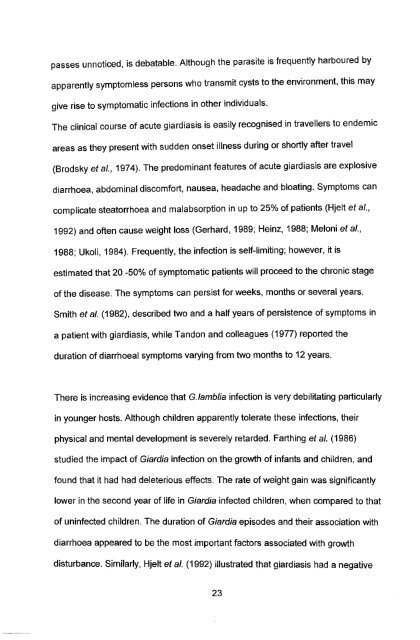in vitro culture and isoenzyme analysis of giardia lamblia
in vitro culture and isoenzyme analysis of giardia lamblia
in vitro culture and isoenzyme analysis of giardia lamblia
Create successful ePaper yourself
Turn your PDF publications into a flip-book with our unique Google optimized e-Paper software.
passes unnoticed, is debatable. Although the parasite is frequently harboured by<br />
apparently symptom less persons who transmit cysts to the environment, this may<br />
give rise to symptomatic <strong>in</strong>fections <strong>in</strong> other <strong>in</strong>dividuals.<br />
The cl<strong>in</strong>ical course <strong>of</strong> acute <strong>giardia</strong>sis is easily recognised <strong>in</strong> travellers to endemic<br />
areas as they present with sudden onset illness dur<strong>in</strong>g or shortly after travel<br />
(8rodsky et al., 1974). The predom<strong>in</strong>ant features <strong>of</strong> acute <strong>giardia</strong>sis are explosive<br />
diarrhoea, abdom<strong>in</strong>al discomfort, nausea, headache <strong>and</strong> bloat<strong>in</strong>g. Symptoms can<br />
complicate steatorrhoea <strong>and</strong> malabsorption <strong>in</strong> up to 25% <strong>of</strong> patients (Hjelt et al.,<br />
1992) <strong>and</strong> <strong>of</strong>ten cause weight loss (Gerhard, 1989; He<strong>in</strong>z, 1988; Meloni et al.,<br />
1988; Ukoli, 1984). Frequently, the <strong>in</strong>fection is self-limit<strong>in</strong>g; however, it is<br />
estimated that 20 -50% <strong>of</strong> symptomatic patients will proceed to the chronic stage<br />
<strong>of</strong> the disease. The symptoms can persist for weeks, months or several years.<br />
Smith et al. (1982), described two <strong>and</strong> a half years <strong>of</strong> persistence <strong>of</strong> symptoms <strong>in</strong><br />
a patient with <strong>giardia</strong>sis, while T<strong>and</strong>on <strong>and</strong> colleagues (1977) reported the<br />
duration <strong>of</strong> diarrhoeal symptoms vary<strong>in</strong>g from two months to 12 years.<br />
There is <strong>in</strong>creas<strong>in</strong>g evidence that G.<strong>lamblia</strong> <strong>in</strong>fection is very debilitat<strong>in</strong>g particularly<br />
<strong>in</strong> younger hosts. Although children apparently tolerate these <strong>in</strong>fections, their<br />
physical <strong>and</strong> mental development is severely retarded. Farth<strong>in</strong>g et al. (1986)<br />
studied the impact <strong>of</strong> Giardia <strong>in</strong>fection on the growth <strong>of</strong> <strong>in</strong>fants <strong>and</strong> children, <strong>and</strong><br />
found that it had had deleterious effects. The rate <strong>of</strong> weight ga<strong>in</strong> was significantly<br />
lower <strong>in</strong> the second year <strong>of</strong> life <strong>in</strong> Giardia <strong>in</strong>fected children, when compared to that<br />
<strong>of</strong> un<strong>in</strong>fected children. The duration <strong>of</strong> Giardia episodes <strong>and</strong> their association with<br />
diarrhoea appeared to be the most important factors associated with growth<br />
disturbance. Similarly, Hjelt et al. (1992) illustrated that <strong>giardia</strong>sis had a negative<br />
23
















